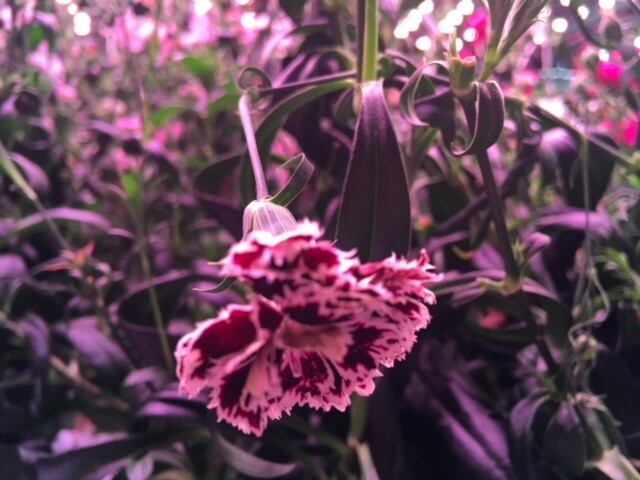Launched in 2016 by entrepreneur Rob Laing, who set upon the quest of ‘growing rare flavors from around the world in the heart of New York’, the concept began with a factory at the Institute of Culinary Education in Manhattan, before expanding to its current 1,200sq ft location in Tribeca.
Pesticide-free rare herbs

Hydroponics is a system whereby plants grow in a water-based nutrient, instead of soil. The environment is controlled by certain types of insects including ladybirds, which eat aphids (sap sucking insects), and smaller ones, hatching in sacks emerging to eat insects, such as a type of parasitic wasp, which tears the inside out of aphids and spider mites.
All the plants in the vertical farm are 100% clean, grown from seed to harvest to produce pesticide-free rare herbs, edible flowers and microgreens, delivered to customers by bike or via the subway (metro).
Farm.One also uses plant-based fertilizers, biodigestive materials, fish waste and bat poo, for bacteria and beneficial fungi to thrive.
Customers include chefs, mixologists, and restaurants including Daniel, Atera, Alex Guarnaschelli’s restaurant Butter, Pizza Loves Emily, Jungsik, Le Turtle, L’Appart, Uchu and more.
Dana Facchine, tour guide, Farm.One, told BeverageDaily Laing, CEO and author of ‘Ditch the Dirt’, started the project as an experiment after he had been travelling abroad and came across some rare herbs he hadn’t seen before and couldn’t find them locally.
“He came home and did some research into indoor farming with LED lights and set up an experimental farm at the Institute of Culinary Education (ICE),” she said.
“At first he wanted to see if he could make herbs and grow plants in that kind of environment, if there was interest from local chefs in the products and if he could sustain it over a period of time. We grew out of that space at ICE after three months so it worked really well for us.
“At the time, Rob (Laing) knew chef Ronny Emborg from Atera restaurant, Atera is very high rated in New York, it has two Michelin Stars and is very hard to get into. Ronny is a friend of Rob’s, he is a big fan of his product and offered him space next to their kitchen for the current Tribeca farm.
“The clear benefit for Atera is that they walk over to the farm to collect fresh herbs and plants mimicking the French ‘potager’ concept where herb and vegetables gardens sit right outside a restaurant where they source their ingredients. We are trying to be farm to table in every sense of the word. We don’t ship out any of our products everything is biked over, walked over or taken on the subway.”
Hyper-Local Sourcing
According to the National Restaurant Association, demand for clean, local food is soaring, and “Hyper-Local Sourcing” is the top trend for 2017.
FarmOne ethos
Focusing on rarity: It scours the globe for rare seeds, looking for edible plants in unlikely places.
Technology & Flavor: Continual focus on improving plant flavor, texture and color.
Staying local: The concept is to stay hyper-local in the heart of the city, even as it grows in size.
Fresh: All produce is delivered same-day, either freshly cut or sold as live plants.
Zero food miles: No emissions are created, no traffic. Customers pick up or they deliver by bike.
From data provided by the Organic Trade Association, sales of Organic produce are expected to grow 70% between 2016-2021. As a result, in 2017 alone, over $250m has been invested in urban vertical farming start-ups, most of whom are focused on mass-market leafy greens for supermarket use.
Farm.One grows over 500 different products, including sour, tangy Wood Sorrel Flowers, spicy red Mizuna microgreens, and a nutty “Dragon’s Tongue” Arugula.
According to Laing, the catalogue spans from the obscure to the necessary, including tangerine gem marigolds to nepitella, a herb from Tuscany that has an odour of mint and oregano. Both are pungent.
"We like to grow things that are small and delicate but have a really powerful impact. They are not just on a plate for appearance. They carry tremendous flavor," he said.
"Chefs tell us exactly what they want. It's grown to order for their recipes. We even know the leaf size the chef wants so we work backward from that.”
Other plants include: micro arugula, red Russian kale, green sorrel, Miz America, mint flowers and blue spice basil.
Products are transported in biodegradable polymer clamp shells and reusable pans.
"Everything we use can either be composted or reused. We have a zero waste approach here. It's the same with our packaging. Chefs either give their packaging back to us, or reuse it," added Laing.
